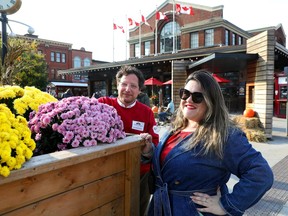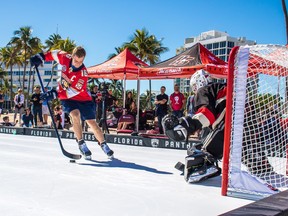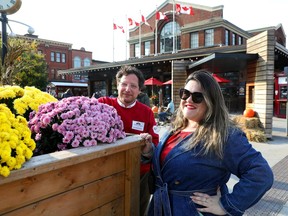Exactly where in the market such a rink would be located hasn’t been determined yet, although the pedestrianized portion of William Street between George and York streets might be a natural fit
Get the latest from Bruce Deachman straight to your inbox

Article content
As the ByWard Market looks to revitalize itself as a year-round go-to destination for residents and visitors alike, officials are looking into purchasing and installing a synthetic outdoor skating rink there.
Zachary Dayler, executive director of the ByWard Market District Authority (BMDA) that oversees development in the area, says his organization is looking into purchasing a 90-by-20-foot synthetic pad, which, before adding in such expenses as lighting, insurance, security and fencing, etc., would cost between $40,000 and $50,000.
Advertisement 2
Article content
Dayler adds that the plan is in its early stages yet and the timeline is far from firm.
“It’s something that we’re eyeing for between 2024 and 2026. But we definitely want to do this.”
Exactly where in the market such a rink would be located hasn’t been determined yet, although the pedestrianized portion of William Street between George and York streets might be a natural fit, as it’s the first thing visitors see when entering the area from the Rideau LRT station at William and Rideau streets. According to Dayler, that is the most used pedestrian gateway to the market.
And while he doesn’t pretend that an 1,800-square-foot outdoor rink will make up for the shortened skating seasons that are becoming increasingly common on the Rideau Canal, Dayler does cite the climate uncertainty as a factor in pursuing a synthetic rink.
“The reason that we’re doing this is we know that the climate is hit or miss. There are a lot of issues, and from an economic perspective, there is the loss that those businesses have had in terms of not having a skating offering, and that hurts the hotels.
“We’re not looking at putting in 12,000 feet of synthetic ice,” he adds. “We’re looking to provide that winter experience in a community.”
Article content
Advertisement 3
Article content
Synthetic skating rinks have evolved greatly since they were first used commercially more than 40 years ago, when they offered little glide, making the experience like skating on a plastic cutting board. Today’s version comes much closer to imitating real ice conditions, and many hockey players use synthetic pads for training.
According to a 2022 story in The Athletic, Nashville Predators forward Ryan O’Reilly has a 25×13 synthetic ice surface in the basement of his home, complete with boards.
“It’s come a long way, and it’s pretty impressive,” he told The Athletic.
“I thought it would be awesome, not only for me, but my kids to use as well. It’s a great setup where you can just go down, put on your skates quickly, and get the closest thing you can to ice.
“In Canada, it’s tough to get ice, just the demand for it. So when you have something where you can mimic that feeling, it’s only going to help your control and handling of the puck. A lot of the skill stuff is something you’ve got to do on your own a bit, so kids too, they can work on their hands without having to find a whole sheet of ice.”
Advertisement 4
Article content

But Dayler and BMDA general manager Mélanie Anderson imagine other uses beyond just public skating. According to Anderson, the Assembly of Seven Generations, or A7G, a grassroots Indigenous youth-led not-for-profit group that operates a store in the ByWard Market building, has already expressed interest in organizing a red-carpet fashion show on the pad.
And Dayler is already considering other possibilities.
“The larger idea of the rink is to see what can we do to be a consistent offering, 300 or 340 days a year, because we’re the capital in a G7 country and this is the centre where it started. So we’ve got to really start amping up our offerings and up our game.
“Let’s get creative here,” he adds. “If we can make this work and we have a synthetic ice offering, then the next year, let’s say we have a synthetic curling offering, and then let’s say we have a synthetic cross-country ski offering.”
“Then let’s say we do Christmas in July,” interrupts Anderson, “and we have it on Canada Day weekend, and we have a three-on-three with the Sens or the PWHL (Professional Women’s Hockey League).”
Advertisement 5
Article content
The BMDA is a not-for-profit municipal services corporation that was formed earlier this year by folding Markets Ottawa and the ByWard Market BIA together to create one organization responsible for implementing the market’s public realm plan. The rink is just one of the ideas it wants to put in place to help bring visitors to the area.
According to its latest figures, foot traffic in the market has climbed to nearly 16 million visitors in the first nine months of 2024, an increase of about 18 per cent over the same period last year and the highest total since the nearly 20 million visitors descended on the area in the same period in 2019, before COVID shuttered the world.
The group recently announced plans for a winter market, for which it will use the 14 red 8×10 modular containers that are now housing vendors to continue showcasing entrepreneurs through the winter. The current leases on the retail spaces expire at the end of October, after which the containers will be winterized and electrified, with the winter market opening from Thursdays to Sundays beginning on Nov. 22 and running until the end of Winterlude on Feb. 17.
Advertisement 6
Article content
Some of the existing container vendors, such as Alkadour Sweets, will likely return, but the BMDA recently announced a call for applications from prospective retailers.
Dayler sees the winter market and rink as opportunities to diversify some of Ottawa’s attractions, particularly during non-peak season months.
He’s already seen it happen, as last year’s warmer temperatures drove more visitors to the market. Of the foot traffic numbers so far this year, January and February showed the greatest increase over 2023’s, at 91 and 24 per cent, respectively.
“The winter market is not a Christmas market,” notes Dayler. “It will include Christmas, but if you think about it, there’s actually never been a winter market offering.”
It’s in that spirit, he adds, that he wants to try new things and see what works in improving the market experience.
“I think this can be the best place of the things that we see and experience in public markets elsewhere. This needs to be a place that reminds people that we’re in a big world and there should be little things that make you happy here.”
Article content


Comments